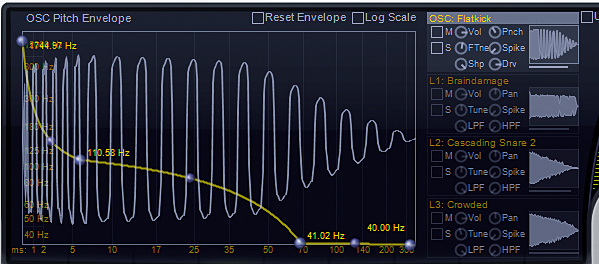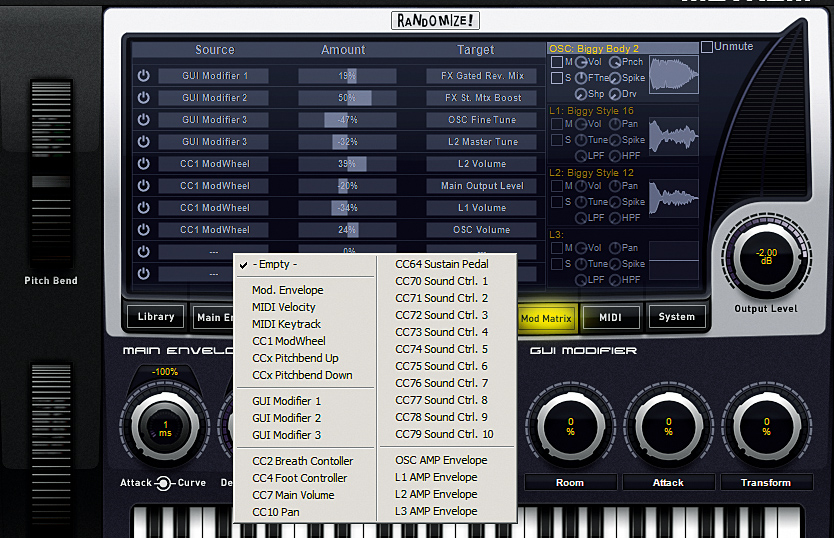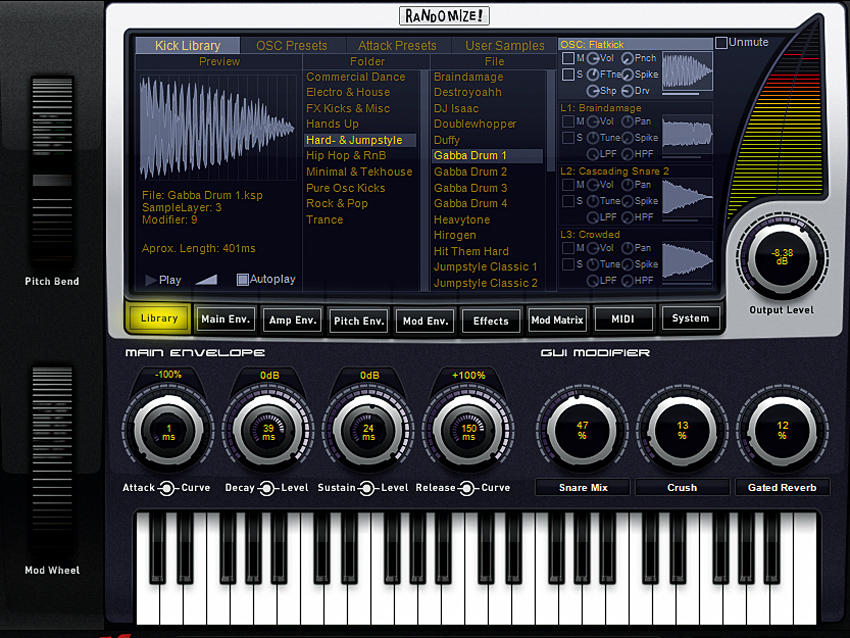MusicRadar Verdict
It's a specialist tool and not for everyone, but Metrum's convenience and quality of sound will delight those who take to it.
Pros
- +
Pro-quality, floor-shaking kicks! Easy to use but potentially quite deep. Excellent presets. Genuinely useful, fun randomise options.
Cons
- -
Pointless virtual keyboard. Spectrum analyser not always visible. No progressive stereo narrowing effect. No undo and minor bugs in v1.0.1.
MusicRadar's got your back
Vengeance-Sound branched out into plug-ins last year with the first in its Vengeance Producer Suite series, Multiband Sidechain. This effect makes it a doddle to achieve sidechain pumping - a very common dance music production technique. Likewise, Metrum aims to make light work of the most fundamental - and often most important - element of any dance track: the kick drum.
Metrum is a VST/AU instrument, and the basic architecture replicates the technique used by Vengeance-Sound's Manuel Schleis to create the killer kicks that his sample packs are renowned for: a synthesised sine wave 'body' layer brings the beef, with up to three sampled 'attacks' layered on top to give character.
There are 330 genre-categorised presets, and they're just as powerful and production-ready as those in Vengeance-Sound's sample libraries. Metrum's smart Librarian is simplicity itself: click a preset to audition, double-click to load it. All presets respond to the mod wheel, and there are three GUI Modifier macro knobs that provide additional sound-shaping options - eg, to dial in extra reverb, reduce the sample rate, fade in a ride cymbal sample, etc. Their functions are assignable, so it varies from preset to preset.
As well as complete kicks, there are presets for individual components: bodies and attacks. 1,800 attack samples are included, covering kick drums (who'd have thought it?), snares, claps, hats, rides, clicks, noise blasts and more. These can be auditioned just like full presets and dragged onto a sample slot. You can set user sample folders, but you can't traverse subdirectories. 24-bit samples also didn't load (this is fixed in the imminent v1.0.2 update).
In detail
Let's look first at the synth oscillator. Like the other layers, its controls are visible at all times. The basics are mute and solo buttons, a volume dial and pitch control. The Shape knob takes the oscillator from a sine wave up to a near-triangle shape, while Drive applies distortion and Spike accentuates attack.
Described as emphasising frequencies in the "stomach region", the Punch knob lives up to its name, adding - or removing - 'oomph' around the 130Hz region. Finally, there's a pitch control. Impressively, the small waveform graphics (and those in the envelope screens) continually update to reflect your tweaks.

The main tone of a kick drum typically starts out high then drops low very quickly. Naturally, then, there's a pitch envelope, and this is the beating, booming heart of Metrum, where you determine whether your kick is a lazy, 808-esque affair; a ballsy 909-alike; a minimal click-meets-sub; a taut, momentary DnB jab; etc. It's an ADSR design, with nodes for each point and curve handles. There's an amplitude envelope, too.
The sample slots also have pitch and amp envelopes, but their basic controls are different: mute, solo and volume are still present, but the rest comprise Pan, Tune, Spike, HPF and LPF, the latter being high- and low-pass filters - vital for slotting sounds into one cohesive kick. At the global level, there's a master amplitude envelope applied to all layers, and a modulation envelope.
"Metrum aims to make light work of the most fundamental - and often most important - element of any dance track: the kick drum."
While you can create stomping kicks without ever going near Metrum's impressive modulation matrix, it's there for those seeking ultimate control. There are ten slots, and you can disable each with a power switch.
Modulation sources include MIDI velocity, key, pitchbend and mod wheel, as well as a selection of CCs. The three GUI Modifier knobs can also be controlled via CC, although this didn't work for us - Vengeance-Sound is aware of the issue and hope to fix it in an update. In the meantime, you can use host automation or set up alternative CC control in the matrix. There's also a dedicated modulation envelope that can be used as a source, and the amplitude envelope of any layer may also function as such.
As for destinations, you're spoilt for choice - pretty much any parameter of the synth can be modulated, including layer settings, effects parameters, the GUI Modifier knobs, the strength of the other modulation slots, and even MIDI keytracking and the root key. We particularly enjoyed binding the mod envelope to effects parameters (eg, bitcrusher frequency) and those of the oscillator, such as Drive and Shape, to add a touch of growl in the decay of the kick, or to sharpen the attack.

More options are found in the MIDI and System pages; for example, you can determine which layers respond to MIDI note (great for pitched jumpstyle kicks) and length, disable the master limiter, and decide what's affected by the excellent randomiser.
Effects
Next, effects. The most basic is a two-band EQ on the entire output. It has a spectrum analyser too, but it's only visible in the Effects page, so you can't see it when you really need to, such as while using the pitch envelope. We'd suggest an option to show an analyser instead of the (somewhat redundant) virtual keyboard.
The rest of the effects can be selectively applied to layers with toggle buttons, so you can easily exclude, say, the oscillator layer from the Distortion section - neat. Other effects are Bit Crusher, Stereo Matrix (widen or convert to mono), Stereo Delay (apply a short delay to either channel, to increase width), Room Reverb and Gated Reverb. The latter is tempo sync'ed so that it's always heard on the offbeat, and it resets when a new note is played, so the reverb never obfuscates the kick itself - also neat! The only effect we're missing is one to narrow the stereo field, rather than just 'mono-ise' sounds.
One big oversight is that there's no undo/redo. Accidentally hit the Randomize! button just as you've dialled in the best kick drum you ever heard in your life and… game over! However, v1.0.2 should be out by the time you read this, with a 'restore last preset' function for such moments, among other new features.
Summary
Metrum delivers the goods for any form of electronic music, be it house (all flavours), hardcore, RnB, hip-hop, DnB, hardstyle, etc. The sound is authentic and thoroughly slammin'. The timing is rock solid, too - as tight as placing samples on an audio track, at least in our test DAWs (Live and Cubase). If creating a kick from scratch, you still need the know-how to be able to tell when it's punching in the right places and not an overblown mess. You'll also have to resist the urge to continually tinker with your kick!
You could always combine your existing synths, samples and effects to create custom kick drums, of course. We cobbled together something like this in Ableton Live using Groups, and while it worked and sounded passable, we have to admit that it wasn't half as quick and easy as Metrum and the results weren't as good.
To sum up, although it's arguably not a vital purchase, the degree of effort and expertise that's gone into making Metrum has clearly paid off. We're sure some producers will wonder how they ever made do without it.
Take a listen to some Metrum presets. Each GUI Modifier is increased in turn, then all three GUI Modifiers are increased together:
Brooklyn Beat 3
UK Trance 3
Rock Kick 2
Jumpstyle Classic 2
Crack Kick
Computer Music magazine is the world’s best selling publication dedicated solely to making great music with your Mac or PC computer. Each issue it brings its lucky readers the best in cutting-edge tutorials, need-to-know, expert software reviews and even all the tools you actually need to make great music today, courtesy of our legendary CM Plugin Suite.
“I have an original 909 – every time I try to use it I feel like I’m ruining it”: House hero Riva Starr on his studio essentials and his love of analogue synths
“A synthesizer that is both easy to use and fun to play whilst maintaining a decent degree of programming depth and flexibility”: PWM Mantis review
“I feel like that song had everything we needed to come back with”: Bring Me The Horizon’s Lee Malia on Shadow Moses, its riff and the secrets behind its tone, and why it was the right anthem at the right time











